woodwinds
All scores that include a part for at least one woodwind instrument.
-
Bruch - Eight Pieces - Alto Flute
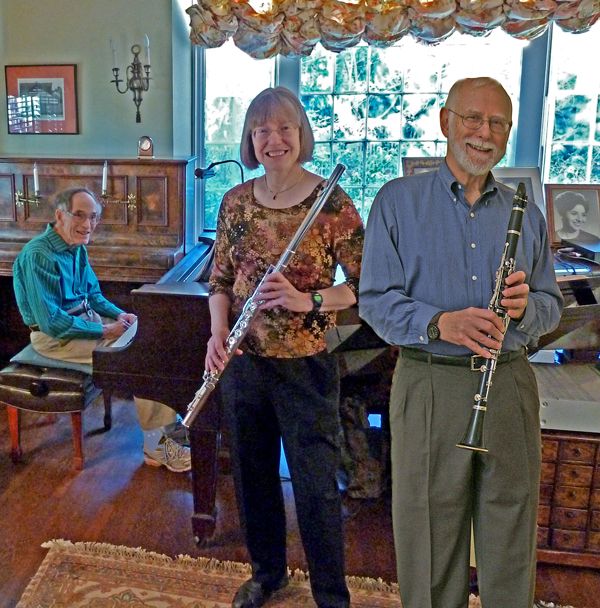 Acht Stücke, Op.83, by Max Bruch
Acht Stücke, Op.83, by Max BruchTranscribed for Clarinet, Alto Flute, and Piano by Davies, Pratt, and Vater
Alto Flute Part, PDF $9.98
Originally scored for clarinet, viola, and piano (or violin, cello, and piano), Bruch's Acht Stücke (Eight Pieces) adapts nicely for a trio with clarinet, alto flute, and piano. Bruch's beautiful melodies are well served by the rich tones of the alto flute.
In creating this transcription of the viola part for alto flute, we have taken great care to maintain the spirit and character of the original instrumentation. We provide here the alto flute part. The piano and clarinet parts are readily available in the public domain as free pdf downloads of the score and parts. Here is a link to one such source: Piano Score and Clarinet Part
Alto Flute part, 17 pages; Total, 19 pages.
Preview -
Schubert – Der Hirt auf dem Felsen – Alto Flute (voice trans.)
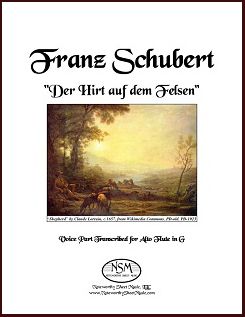 Der Hirt auf dem Felsen, Op.129, by F. Schubert
Der Hirt auf dem Felsen, Op.129, by F. Schubert Voice Part Transcribed for Alto Flute in G by Carol A. Vater
Alto Flute Part, PDF $5.99
NSM published Peter H. Bloom's alto flute transcription of the clarinet obbligato from Schubert's Shepherd on the Rock in 2012. Please find information about that publication in our article for that edition. Later we realized that the voice part, which I have performed on flute in a flute/clarinet/piano group, would work much better when played on alto flute. So we created a transcription of the vocal part for alto flute. This alto flute transcription is to be played in an entirely instrumental version of Der Hirt auf dem Felsen for alto flute, clarinet (or alto flute), and piano, which as noted by Mr. Bloom, is "an ideal didactical vehicle for coaching the developing flutist in the art of rhetorical performance as well as a splendid concert/recital piece." Our alto flute transcription of the voice part is a simple transposition requiring no octave changes; the part falls naturally and beautifully within the alto flute range. The clarinet part and piano score are freely available at IMSLP.org.
Preview -
Bridge – 4 Short Pieces – Flute or Alto Flute (and Piano)
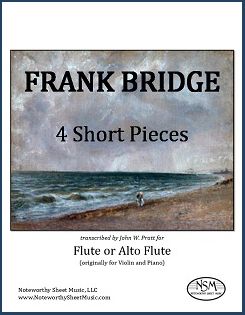 4 Short Pieces, by Frank Bridge
4 Short Pieces, by Frank BridgeTranscribed for Flute or Alto Flute (and Piano) by J.W.Pratt
Flute Part, Alto Part, PDF $8.99
The 4 Short Pieces by Frank Bridge were written for violin and piano, and first published in 1912. As noted in John Pratt's foreword to the edition, they "provide a fine and delightful introduction to an accessible post-romantic composer who should be better known." The pieces are "Meditation", "Spring Song", "Lullaby", and "Country Dance". Mr. Pratt has created transcriptions of the violin parts for both flute and alto flute, and we include both instrument versions in this edition. We think Nos. 1 and 3 sound particularly nice on the alto flute and No. 4 is a splendid romp on the C flute, but all four are effective on either instrument, so we prefer to let our flutists decide on which instrument they choose to play each piece. We provide only our flute and alto flute transcriptions; the piano score, including the original violin part, is available as a free pdf download at imslp.org.Flute part, 5 pages; Alto Flute part, 5 pages; Total, 14 pages.
Preview
-
Bridge – 4 More Short Pieces – Flute or Alto Flute (and Piano)
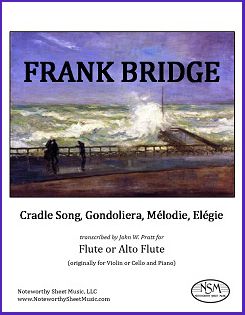 Cradle Song, Gondoliera, Mélodie, and Elégie, by Frank Bridge
Cradle Song, Gondoliera, Mélodie, and Elégie, by Frank BridgeTranscribed for Flute or Alto Flute (and Piano) by J. W. Pratt
Preview
Flute Part, Alto Part, PDF $11.99
Like the 4 Short Pieces for Violin and Pianoforte published in transcription by Noteworthy Sheet Music earlier this year, these additional four short pieces by Bridge "provide a fine and delightful introduction to an accessible post-romantic composer who should be better known." Published by Bridge between 1903 and 1911, the works included in our second edition are transcriptions of Cradle Song, written for violin or cello and piano, Gondoliera for violin and piano, and Mélodie and Elégie for cello and piano. Mr. Pratt has created transcriptions of all four pieces for both flute and alto flute, and we include both instrument versions in this combined edition. We think Cradle Song and Elégie are particularly beautiful on the alto flute, but all are effective on either instrument, so we prefer to let our flutists decide on which instrument they choose to play each piece. We provide our flute and alto flute parts only; the original piano scores work well with our transcriptions and are available, along with the violin and cello parts, as free pdf downloads at imslp.org—click the links to access the scores for Cradle Song, Gondoliera, Mélodie, and Elégie.
Flute part, 6 pages; Alto Flute part, 6 pages; Total, 14 pages. -
Beach - Ecstasy - Voice (or Afl), Alto Flute (or Cl), and Piano
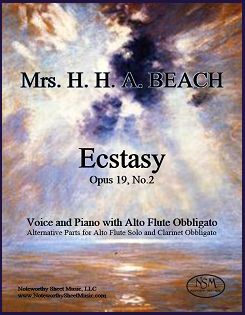 Ecstasy, Op.19 No.2, by Mrs. H. H. A. Beach
Ecstasy, Op.19 No.2, by Mrs. H. H. A. Beach
Two versions, for "Low voice (in Db)" or "High voice (in Eb)", with Alto Flute Obbligato (transcribed) and Piano.
Alternative parts for Alto Flute Solo and Bb Clarinet Obbligato.
Program Notes by Peter H. Bloom.
Piano Scores, Voice Parts, Alto Flute Obbligato Parts, and alternative Alto Flute Solo Parts and Clarinet Obbligato Parts; PDF $8.99Noteworthy Sheet Music is thrilled to publish our edition of Amy Marcy Cheney Beach's song Ecstasy in 2017, in celebration of the 150th anniversary of the composer's birth. The idea to make Ecstasy available to a broader combination of players and singers came from flutist Peter H. Bloom, who proposed that the piece would be an excellent vehicle with which instructors might inform students (early and advanced alike) about interpretation of the highly romantic late 19th century idiom. To that end, we have packaged together in a single edition Mrs. H. H. A. Beach's two versions of Ecstasy, for "low voice (in Db)" and "high voice (in Eb)", with each version including transcriptions of the obbligato (originally for violin) for either alto flute in G or clarinet in Bb, and an alternative solo part in the form of an alto flute transcription of the voice line. Thus, multiple performance variations are possible, including high or low voice and piano with either alto flute or clarinet obbligato, or fully instrumental versions for alto flute and piano, or two alto flutes and piano, or alto flute, clarinet, and piano.
Scores, 8 pages (4 pages each version); Voice parts, 2 pages (1 page each version); Alto Flute Obbligatos, 2 pages (1 page each version); Clarinet Obbligatos, 2 pages (1 page each version); Alto Flute solo parts, 2 pages (1 page each version); Total, 20 pages.
Preview -
Finlayson - Moon Shadows - Winds and Percussion
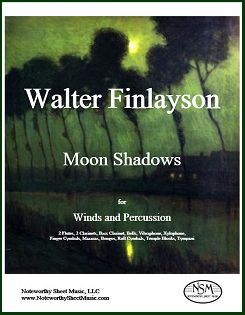 Moon Shadows, by Walter A. Finlayson
Moon Shadows, by Walter A. FinlaysonContemporary Composition for 2 Flutes, 2 Clarinets, Bass Clarinet, and 9 Percussion Instruments
Score and Parts, PDF $14.25
Walter Finlayson (1919-2000) was an American composer, musician, educator, and music innovator, with nearly twenty original compositions and some forty arrangements to his credit. While serving in the navy, he played saxophone and clarinet in the US Naval Reserve dance band, seated next to the great Artie Shaw. Finlayson's ASCAP output includes music for band, dance band, orchestra, voice, and chorus. His compositions and arrangements have been published by Boosey & Hawkes, EB Marks, Boston Music, and Mercury Music, and performed by major college marching band programs. One of his best-known compositions is I Had a Premonition, which was written for voice and piano, but which was later arranged for the Jimmie Lunceford Orchestra, one of the preeminent bands of the swing era. A recording of the tune can be heard on The Jimmie Lunceford Collection: 1930-47 compact disc released in 2014 on the Fabulous label, and on YouTube.
Noteworthy Sheet Music's chief editorial consultant Peter H. Bloom received Finlayson's previously-unpublished score for Moon Shadows from the composer's daughter, and we were impressed with its quality and sophistication. For a piece written in the late 1930's or early 1940's, as Gale Finlayson recollects (the score is not dated), Moon Shadows seems remarkably ahead of its time. The work is scored for two flutes, two clarinets, bass clarinet, bells, vibraphone, xylophone, finger cymbals, maracas, bongos, roll cymbals, temple blocks, and tympani. We notated our modern edition of the piece as faithfully as possible based on the hand-written Finlayson score; our edition of Moon Shadows includes both score and parts. We at NSM are pleased to aid in the re-discovery of some of Walter Finlayson's works; for additional information about this interesting composer, please visit the Our Composers page under About Us.
Score, 19 pages; Parts for Flute-1, Flute-2, Clarinet-1, Clarinet-2, Bass Clarinet, Bells, Vibraphone, Xylophone, Finger Cymbals and Maracas, Bongos and Roll Cymbals, Temple Blocks, and Tympani, 1 page each; Total, 34 pages.
Preview -
Hoffmeister - Sonata in D minor - Flute and Clarinet
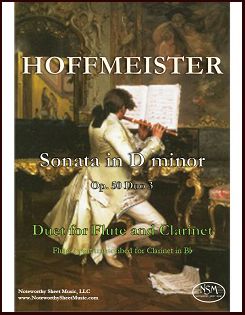 Sonata in D minor, Op.50, Duo 3, by Franz Anton Hoffmeister
Sonata in D minor, Op.50, Duo 3, by Franz Anton Hoffmeister
Duet transcribed for Flute and Bb Clarinet
Score and Parts, PDF $11.25
Noteworthy Sheet Music published an edition of the Sonata in D minor, Duo 3 from Hoffmeister's Trois Duos pour Deux Flûtes, Op.50, after being contacted by flutist Richard A. Evans. Years ago, Mr. Evans had located several editions of 18th and 19th century flute duets, long since out of print, at the Library of Congress. Finding them quite enjoyable to play, and believing them undeserving of their current obscurity, he and his music colleague Bronnie Stroud took the initiative of re-typesetting and editing the pieces using a modern music notation software program. Aware of the paucity of repertoire available for flute and clarinet duo, and realizing these pieces would work nicely for that instrument pair as well, he also transcribed the second flute parts for Bb clarinet. We at NSM agreed that these works should be made more readily available to present-day musicians and audiences, and we published them after making only minor stylistic and formatting revisions to Mr. Evans' scores and parts; the articulation and dynamic markings are those suggested by Mr. Evans.
Preview
Score, 15 pages; Flute part, 8 pages; Bb Clarinet part 8 pages; Total, 34 pages.
-
Cambini - Sonata in D Major - Flute and Clarinet
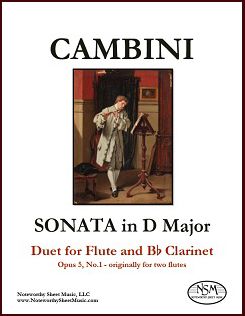 Sonata in D Major, Op.5, No.1, by Giuseppe Maria Cambini
Sonata in D Major, Op.5, No.1, by Giuseppe Maria CambiniTranscribed for Flute and B-flat Clarinet by R.A.Evans
Score and Parts, PDF $7.99Giuseppe Maria Cambini (1746-1825) was an Italian-born violinist and composer. He was one of the most prolific composers of his era, particularly of instrumental works, of which he wrote over 600, including numerous symphonies, 149 string quartets and over 100 trios, as well as ballets, operas, & oratorios. Flutists will know him for his concertos and extensive body of chamber works featuring the flute, including duos, trios, quartets and quintets.
Cambini wrote his Sonata in D Major, Op.5, No.1 for two flutes, and Noteworthy Sheet Music has published a re-notated version of the flute duet at the suggestion of flutist Richard A. Evans, who long ago obtained the music from the Library of Congress and believed it undeserving of its current obscurity. Aware of the scarcity of music composed for flute-clarinet duos, Mr. Evans also initiated this flute-clarinet edition of Cambini's Sonata in D Major by transcribing the flute-2 part for clarinet in B-flat. We at NSM agreed that the Op.5, No.1 duet should be made more readily available to present-day musicians and audiences, in both the flute-flute and flute-clarinet versions. Our editions provide both scores and parts, and incorporate articulation and dynamic edits supplied by Mr. Evans.Score, 8 pages; Flute part, 4 pages; B-flat Clarinet part 4 pages; Total, 22 pages.
Preview -
Devienne - Sonata in D Major - Flute and Clarinet
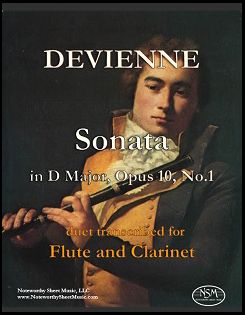 Sonata in D Major, Op.10, No.1, by François Devienne
Sonata in D Major, Op.10, No.1, by François DevienneDuet transcribed for Flute and Clarinet
Score and Parts, PDF $9.99François Devienne (1759-1803) was a French composer, flutist and bassoonist, as well as a professor at the Paris Conservatory. His compositional output included: 12 operas; many concerted pieces for various wind instruments, with orchestra; overtures; concertos, quartets, trios, sonatas, etc. for flute, piano, and other instruments; 12 suites; numerous romances, chansons, etc.; and an influential flute method book, Méthode de flûte (1795).
Noteworthy Sheet Music published this edition of Devienne's Sonata in D Major, Op.10, No.1 at the suggestion of flutist Richard A. Evans, who long ago obtained the original flute-flute duet from the Library of Congress and believed it undeserving of its current obscurity. Aware of the paucity of repertoire available for flute and clarinet, and realizing the piece would work nicely for that instrument pair as well, he transcribed the second flute part for B♭ clarinet. We at NSM agreed that the duet, which has two movements, Allegro spirituoso and Rondo: Allegro poco presto, should be made more readily available to present-day musicians and audiences. Our edition provides both score and parts and incorporates articulation and dynamic edits supplied by Mr. Evans.Score, 10 pages; Flute part, 5 pages; B♭ clarinet part, 5 pages; Total, 24 pages.
-
Schumann, Clara - Three Romances - Alto Flute or Flute (and Piano)
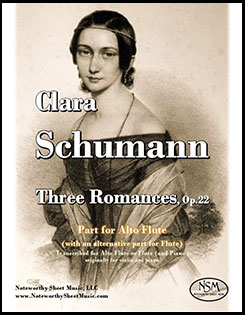 Three Romances, Op.22, by Clara Schumann
Three Romances, Op.22, by Clara SchumannTranscribed for Alto Flute or Flute (and Piano) by C.A.Vater
Alto Flute Part and alternative Flute Part, PDF $8.99
Clara Schumann’s Drei Romanzen für Pianoforte und Violine, Op. 22, were written in 1853 and dedicated to the Schumanns’ great friend, the famous Hungarian violin virtuoso Joseph Joachim, with whom Clara performed the Three Romances when they concertized together on tours across Europe. The Romances are lovely, short pieces; melodic and expressive, they epitomize the Romantic era and represent true chamber music in the sense that both instruments are featured comparably, rather than the piano having a merely accompaniment role. They are nicely adaptable to wind instruments, and are particularly lovely when played on alto flute. Our transcription required few modifications to bring the original violin part completely in range for alto flute and provide flute-friendly, musically-appropriate alternatives to the occasional violin double-stop. Some flutists may wish to mix and match the three movements, preferring to play one or two of the Romances on alto flute and the third on concert flute, or vice versa; so, to that end, we have included in this edition a complete alternative part adapted for C-flute. We do not provide a re-notated copy of the score, however, since high-quality PDFs of the piano and violin score are freely available in the public domain, and are easy to use along with our flute transcriptions of the violin line. To download one such PDF of the score, please visit the imslp website.
Alto Flute part, 5 pages; Flute part, 5 pages; Total 14 pages.
Preview -
Glazunov - Elegy - Flute or Alto Flute
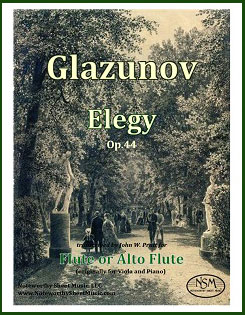 Elegy, Op.44, by Alexander Glazunov
Elegy, Op.44, by Alexander GlazunovTranscribed for Flute or Alto Flute (and Piano) by John W. Pratt
Parts for Flute and Alto Flute, PDF $5.99
Alexander Konstantinovich Glazunov (1865-1936) was a major composer in the late Russian romantic tradition. His Elegy, Op.44, was written for viola and piano in 1893. The viola melody is readily adaptable for other instruments, since it is without double stops, and has been transcribed here by John W. Pratt for either flute or alto flute. The piece is about 6 minutes long, elegiac but not lugubrious. It consists of a lovely melody in 9/8 time, enhanced by a simple but warm piano accompaniment. The NSM edition includes a flute part and an alternative alto flute part, but does not include one for piano, since a suitable score is freely available at IMSLP.org.
Flute part, 2 pages; Alto Flute part, 2 pages; Total, 8 pages.
Preview -
Danzi - Grande Sonate - Piano & Basset Horn
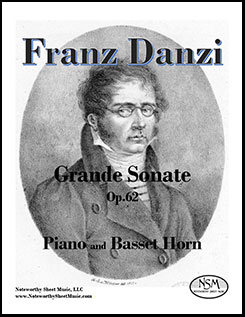 Grande Sonate, Op.62, by Franz Danzi
Grande Sonate, Op.62, by Franz Danzifor Piano and Basset Horn; re-notated, edited, and with occasional ossia elaborations suggested by John W. Pratt
Piano Score and Basset Horn Part, PDF $13.99
Franz Danzi (1763-1826) was an active musician, cellist, and teacher in Mannheim, Munich, Stuttgart, and Karlsruhe. A prolific composer, especially of music for the stage and chamber music from keyboard solos to sextets, he revered Mozart and mentored Weber. His wind quintets are notable. His Grande Sonate, Opus 62, for piano and basset horn, was published about 1823, along with an alternative cello part which sometimes differs from the basset horn part in other ways than octave transposition. // The original publication of Danzi’s Opus 62 is available at imslp.org., but there is no full score and the parts are hard to play from, or sometimes even to read at all, lack measure numbers, have a few errors, and differ in the number of measures in the last two movements. We have therefore prepared a full score including the basset horn in concert pitch, to facilitate checking the fit of the basset horn and piano lines and our transcriptions for other instruments against the original. — excerpted from John Pratt’s foreword to the edition
Piano Score, 28 pages; Basset Horn part, 7 pages; Total 40 pages.
Preview -
Burleigh - Southland Sketches, Nos. I, III, IV - Alto Flute or Flute (& piano)
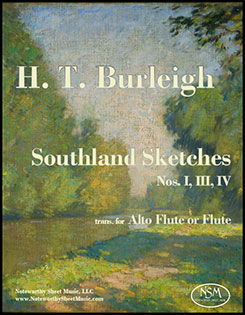 Southland Sketches, Nos. I, III, IV, by H. T. Burleigh
Southland Sketches, Nos. I, III, IV, by H. T. BurleighTranscribed for Alto Flute or Flute (and piano) by C. A. Vater
Alto Flute part and Flute part, PDF $9.96
Harry Thacker Burleigh was an acclaimed African-American singer, music editor, and composer whose adaptations of African-American spirituals became famous. His Southland Sketches, which were composed for violin and piano and published by G. Ricordi in 1916, are a fine example of Burleigh’s quintessential American style. The original composition included 4 movements. Our edition excludes the second movement, but adapts three of the original four miniatures for either alto flute or flute. We provide only the transcribed alto flute and flute parts, as they have been designed to work well with the piano part in the original score for violin and piano which is available as a good quality, free pdf download from imslp.org. Performers may choose to play all three of these pieces on either flute or alto flute, or switch instruments between sketches, depending on personal preference.
Alto Flute part, 6 pages; alternate Flute part, 6 pages; Total,18 pages. (pdf of piano accompaniment is freely available at imslp.org)
Preview
-
Schnauber - Not-Pooh Songs - Female Voice and Flute or Female Voice and Oboe
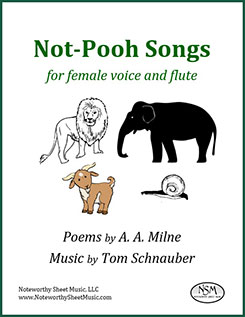 Not-Pooh Songs, by Tom Schnauber
Not-Pooh Songs, by Tom SchnauberFor Female Voice and Flute or Female Voice and Oboe, 2 editions
Score for Female Voice and Flute, PDF $18.46
Score for Female Voice and Oboe, PDF $18.46Tom Schnauber’s Not-Pooh Songs are absolutely delightful. The composer has set to music six children’s poems by A. A. Milne, four from When We Were Very Very Young (“The Alchemist”, “The Mirror”, “The Four Friends”, and “If I Were King”) and two from Now We Are Six ("The Charcoal Burner" and "The Engineer"). The work is offered by Noteworthy Sheet Music, LLC in two publications, one for female voice and flute, the other for female voice and oboe. The oboe line is sufficiently different from the flute line in terms of register to warrant it being published as a separate edition (i.e., the flute version makes use of that instrument’s wider range by putting some material in higher octaves). Also, the flute edition includes an alternate variation of “The Mirror” for voice and alto flute, whereas the oboe edition includes an alternate variation of “The Mirror” for voice and English horn.
It’s clear from hearing this music that Schnauber gets a real kick out of Milne’s poetry. The flute/oboe comments, echoes, etc. go with or against the voice line very effectively and entertainingly. These songs will have broad appeal to both players and audiences, and there’s a lot that a pair of performers could do with them. The music isn’t easy, but provides just the sort of challenges that the adventuresome player loves; in places, for example, the flute jumps from C7 to C4, plays multiphonics, and executes finger snaps. But, as the composer has pointed out, just because the music is somewhat demanding doesn’t mean that it should be presented seriously in performance; on the contrary, players should have fun with these pieces and convey the intended joy and playfulness of the work.
Note that both performers are to play from the score, so flutists and oboists may want to print their copy of the score single-sided to avoid a few difficult page turns.
To listen to a recording of Not-Pooh Songsperformed by Mitsi Westra, voice, and Pamela French, oboe, visit Tom Schnauber’s SoundCloud page at https://soundcloud.com/user-557772917/sets/not-pooh-songs.
► Schnauber - Not-Pooh Songs - Voice and Flute - PDF
 Preview: Not-Pooh Songs for Voice and Flute, p1
Preview: Not-Pooh Songs for Voice and Flute, p1Score for female voice and flute, 22 pages; Lyrics, 2 pages; Total, 28 pages.
► Schnauber - Not-Pooh Songs - Voice and Oboe - PDF
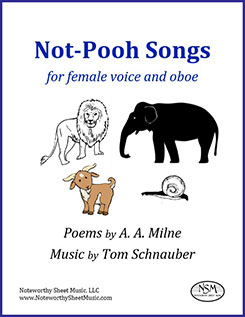 Preview: Not-Pooh Songs for Voice and Oboe, p7
Preview: Not-Pooh Songs for Voice and Oboe, p7 Score for female voice and oboe, 22 pages; Lyrics, 2 pages; Total 28 pages
Front cover images courtesy of Wikipedia.org, Wikimedia.org, and Free Vector Snail Clip Art; Asian Elephant and Lion files are made available under the Creative Commons CC0 1.0 Universal Public Domain Dedication.
- Elephant: author: Shyamal, https://en.m.wikipedia.org/wiki/File:Asian_Elephant_Icon.svg
- Lion: author: openclipart.org, https://commons.wikimedia.org/wiki/File:Lion_clipart.svg
- Goat: released into the public domain by its author, LadyofHats. https://commons.wikimedia.org/wiki/File: Goat_cartoon_04.svg
- Snail: Free Vector Snail Clip Art: Snail Clip Art is a completely free picture material, which can be downloaded and shared unlimitedly.
https://www.seekpng.com/ipng/u2q8y3t4a9e6a9q8_free-vector-snail-clip-art-snail-clip-art/ -
Arriaga - Quartet No.1 - Flute
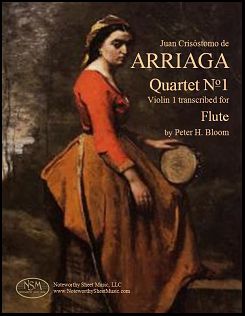 Quartet No.1, by Juan Crisóstomo de Arriaga
Quartet No.1, by Juan Crisóstomo de ArriagaViolin 1 Transcribed for Flute by Peter H. Bloom
Flute Part, PDF $9.95
Peter H. Bloom wrote the following foreword (© 2014):
"Even among the most celebrated musical prodigies (Mozart, Mendelssohn, Pergolesi, and Varèse, for example) Juan Crisóstomo de Arriaga's genius and technical mastery are exceptional. This D-minor quartet, one of three string quartets written in 1824, is a work of structural brilliance, rhetorical grace, and elegant intensity.
Adapting music originally written for violin to flute is often relatively straightforward. Occasional octave reassignment and re-interpretation of double stops are typical changes. But when a flute assumes the voice of the first violin in the context of a string quartet, further accommodations are usually necessary. Dynamic balance, sonority, clarity of phrasing and consistency of articulation among the ensemble require a reassessment of many interpretive indications that are native to the violin. In this arrangement we have, as a rule, eliminated Portato indications; they are useful for violinists but merely distracting to the flutist. Articulation and phrasing marks have occasionally been changed, or eliminated, in instances where violin-orientated directions might mislead the flutist.
A final thought: The flutist proposing to replace the first violin in a string quartet of this beauty and integrity may meet resistance from string-playing colleagues. After a fair reading, however, they'll share your enthusiasm for Arriaga's Quartet in D-minor for Flute and Strings."
P. H. Bloom, Somerville, MA
29, May 2014 ©
We provide only the transcribed Flute part. The Violin 2, Viola, and Cello parts, as well as the original Violin 1 part, are in the public domain and available as free PDFs downloads from IMSLP.org.
Flute part, 9 pages; Total, 12 pages.
Preview -
Brahms - Two Songs, Op.91 - Clarinet
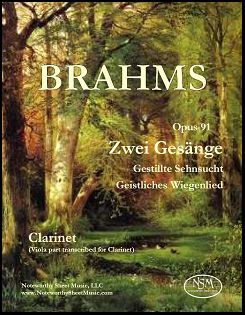 Two Songs, Op.91, by Johannes Brahms
Two Songs, Op.91, by Johannes BrahmsTranscribed for Clarinet by John W. Pratt (part originally for viola)
Clarinet Part, PDF $6.99
The two chamber music songs of Brahms' Zwei Gesänge, Op.91 were composed specifically for his dear friends, the violinist/violist Joseph Joachim and the mezzo-soprano Amalie Schneeweiss, who were married in 1863. The songs (for alto, viola, and piano) were written over 20 years apart, but Brahms published them together as Op.91 in 1884.
"Gestillte Sehnsucht", which appears first in the Op.91 pairing, was actually written second, in 1884. The song sets the text of the poem by Friedrich Rückert (1788-1866). "Gestillte Sehnsucht" is a nature poem, filled with images of forests at sunset, gentle breezes, and twittering birds. Rückert is famous not only for his exquisite poems themselves but also for the great inspiration his work provided to numerous prominent composers, in addition to Brahms. "Geistliches Wiegenlied" (Sacred Cradle Song) was first composed in 1863-1864, and later revised. The viola opens with the melody of the medieval Christmas carol "Joseph, lieber Joseph mein." The singer has her own variation of the melody, and enters after the first stanza of the viola's carol. The song is a beautiful cradle-rocking lullaby, in 6/8 time.
It is said that the viola was Brahms' favorite stringed instrument, and the composer gave the viola a major role in both of these songs, allowing it to open both pieces before the singer enters. Clarinetists have long coveted these viola parts, and various performances have provided clear evidence that a successful outcome can be achieved with the substitution of a clarinet for the viola in Op.91. So when a clarinetist friend of ours asked us to create a transcription for him, we gladly obliged. Our edition of the clarinet part adapts the first song, "Gestillte Sehnsucht", for clarinet in A, and the second, "Geistliches Wiegenlied", for clarinet in Bb. The original piano score and voice part are in the public domain, readily available as free PDF downloads from IMSLP.org.
Clarinet part, 4 pages; Total, 8 pages.
Preview -
Mozart - Concerto in Eb Major, K.495 - Alto Flute
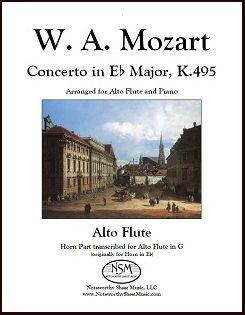 Concerto in E-flat Major, K.495, by W. A. Mozart
Concerto in E-flat Major, K.495, by W. A. MozartTranscribed for Alto Flute (from horn and piano arrangement) by C.A.Vater
Alto Flute Part, PDF $7.99
Mozart's Horn Concerto No.4, K.495, was composed in 1786 and scored for solo horn, with two oboes, two horns, and strings (bassoon ad libitum). The work consists of three movements—Allegro moderato, Romanza-Andante, and Rondo-Allegro vivace—with the rousing Rondo clearly evoking a hunt scene. The horn player Henri Kling (1842-1918) created arrangements of all the Mozart horn concerti for horn and piano. His transcription of K.495 was published by Breitkopf und Härtel, n.d. (ca. 1882). We used the Kling edition, now in the public domain and available as a free pdf download from imslp.org, to create a transcription of the horn part for alto flute. Our edition incorporates adjustments that account for differences in range and sonority between the alto flute and horn, while striving to maintain the style and character of the original composition.
We provide the alto flute part only; the piano score (horn and piano) by Henri Kling is freely available from imslp.org.
Alto Flute part, 7 pages; Total, 10 pages.
Preview -
Mozart - Concerto in Eb Major, K.447 - Alto Flute
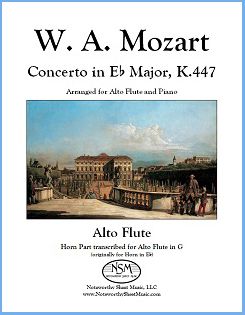 Concerto in E-flat Major, K.447, by W. A. Mozart
Concerto in E-flat Major, K.447, by W. A. MozartTranscribed for Alto Flute (from horn and piano arrangement) by C.A.Vater
Alto Flute Part, PDF $5.99
Wolfgang Amadeus Mozart (1756-1791) wrote four horn concertos for his good friend Joseph Leutgeb (1732-1811). Leutgeb was a virtuoso horn player, who served as principal horn in Salzburg and thus became a colleague of Leopold Mozart, during the young Wolfgang's early years. Leutgeb appears to have remained a friend and inspiration for W. A. Mozart throughout the composer's life.
The Mozart horn concertos are delightful, joyous works. The third horn concerto, K.447, like two of the three others, was written in the key of E-flat major. It is thought to have been composed in 1787. The work is in typical concerto form, consisting of three movements—an Allegro, a Romanze, and another Allegro, which together have an average performance duration time of approximately 15 minutes.
K.447, Concerto for Horn in E-flat major for Horn and Orchestra, is scored for solo horn in E-flat, with two clarinets, two bassoons, and strings. Henri Kling (1842-1918), a horn player who was also a composer, conductor, and professor, arranged the concerto for horn and piano. His transcription was published by Breitkopf und Härtel, n.d. (ca. 1890). We used the Kling edition, now in the public domain and available as a free pdf download from imslp.org, to create a transcription of the horn part for alto flute. Our edition incorporates adjustments that account for differences in range and sonority between the alto flute and horn, while striving to maintain the style and character of the original composition.
We provide the alto flute part only; the piano score (horn and piano) by Henri Kling is freely available from imslp.org.
Alto Flute part, 5 pages; Total, 8 pages.
Preview -
Bloom - Ablaze She Came in the Dream - Flute, Viola, and Guitar
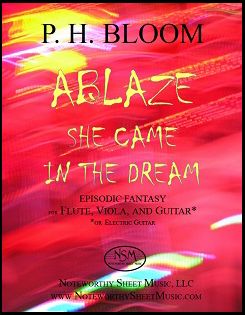 Ablaze She Came in the Dream, by Peter H. Bloom
Ablaze She Came in the Dream, by Peter H. BloomContemporary Composition for Flute, Viola, and Guitar (or Electric Guitar)
Flute, Viola, & Guitar Parts and Score, PDF $22.97
Flutist Peter H. Bloom is no stranger to Noteworthy Sheet Music or to our customers, as he has contributed several popular arrangements and transcriptions to our catalog and he also serves as an editorial consultant for NSM.
Now we are very pleased to offer this newly published (2014) and highly intriguing original composition by Mr. Bloom entitled Ablaze She Came in the Dream. The piece comprises eleven brief episodes written for the unusual trio combination of flute, viola, and guitar (or electric guitar). Ablaze is intended to serve as an interpretive vehicle for the performers and thus should be executed freely and expressively. The work is suitable for advanced players.
Click to access a recording of the premier performance of Ablaze which took place on November 21, 2014 in Boston, MA, as part of the Church of the Advent Library Concert Series. The performance features Peter H. Bloom on flute, Frank Grimes on viola, and Anastasiya Dumma on electric guitar.
Score, 23 pages; Flute Part, 11 pages; Guitar Part, 12 pages; Viola Part, 12 pages; Total, 66 pages.
Preview
====================================
We also offer a professionally-printed hard copy edition of Ablaze She Came in the Dream for $45.88 plus a $5.95 shipping and handling fee. Due to prohibitively high international shipping rates, we ship print editions only to addresses in the USA. Please use the Contact Us form to let us know which hard copy publication(s) you would like to purchase, along with your email contact information and USPS mailing address. We will then send you a PayPal invoice for the sale and, once we receive notice from PayPal that you have paid for the item(s), we will ship your music to the address provided for delivery in 7-10 business days. -
Bauer - Sonata - Alto Flute
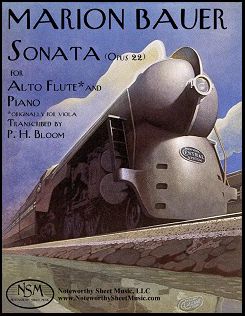 Sonata, Op.22, by Marion Bauer
Sonata, Op.22, by Marion BauerTranscribed for Alto Flute by Peter H. Bloom (originally for viola)
Alto Flute Part, PDF $11.79
The following notes are excerpted, with permission, from the complete copyrighted foreword written by Peter H. Bloom for the Noteworthy Sheet Music edition of his transcription:
"The career of Marion Eugenie Bauer (1882-1955) as a composer, editor, writer, teacher, supportive colleague and mentor continues to assert a significant impact on the trajectory of American Music. It's mysterious that her legacy has been so rarely recalled and her music so infrequently performed in the six decades following her death. ... In 1906 she was the first of generations of American composers to study in Paris with the redoubtable Nadia Boulanger. ... We're fortunate that the composer crafted her own superb transcription of this sonata for clarinet and piano. In order to achieve the equivalent musical impact, her viola and clarinet versions differ in some places. The piano part, nevertheless, remains unchanged. Sometimes we've opted for the clarinet version, sometimes the viola version, and sometimes a conflation of the two. We have also made a few adaptive changes in tessitura, articulation, phrasing and dynamics to highlight the unique voice of the alto flute. Though execution may occasionally differ, the rhetorical and emotional shape of the work remains essentially the same."
P. H. Bloom, © January 7, 2014
We provide our alto flute transcription; the piano part is readily available as a free pdf download of the score from sources such as imslp.org/.
Alto Flute part, 9 pages of music; Total, 12 pages.
Preview